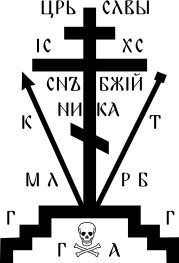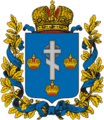|
تضامنًا مع حق الشعب الفلسطيني |
صليب أرثوذكسي

الصليب الأرثوذكسي أو البيزنطي [1][2][3] أو الصليب الروسي، [4][5][6] المعروف أيضا باسم الصليب ذو المسند (Suppedaneum) وهو رف يستعمل لوقوف المصلوب هو اختلاف عن الصليب المسيحي، يوجد عادة في الكنائس الأرثوذكسية الشرقية، فضلا عن الكنائس الشرقية الكاثوليكية من المجتمع البيزنطي ومجتمع الكنائس الشرقية الأنغليكانية. الصليب ذو ثلاثة أكتاف-الأفقي يمثل أعلى لوحة منقوش عليها INRI (Latin: Iēsus Nazarēnus, Rēx Iūdaeōrum) وتعني المسيح ملك بني إسرائيل، وفي الأسفل، مسند للقدمين. في التقليد الأرثوذكسي الروسي، وانخفاض الشعاع المائل إلى يمين المصلوب عادة ما يكون أعلى من ذلك. وذلك لأن ميول مسند القدمين صعودا نحو اللص التائب القديس ديسماس المصلوب على يمين المصلوب، والطرف النازل نحو غيستاس. الإصدار الأقدم من موطئ الأقدام المائل يمكن العثور عليه في القدس، ولكن في جميع أنحاء العالم المسيحي الشرقي حتى القرن 17، ويميل مسند القدمين في الاتجاه الآخر، مشيرا صعودا وليس هبوطا، مما يجعل الموطئ النزولي ابتكار روسي. في اليونانية ومعظم الكنائس الأرثوذكسية الأخرى، يبقى مسند القدمين أفقي، كما في التمثيل في وقت سابق. وتشمل الاختلافات الشائعة أيضا «الصليب فوق الهلال» و «صليب الجمجمة».
نماذج روسية

واحد من الاختلافات عن الصليب الأرثوذكسي هو 'الصليب على الهلال ". "في 1486، القيصر إيفان الرابع (الرهيب) احتل مدينة قازان التي كانت تحت حكم المسلمين التتار، وفي هذه الذكرى، أصدر مرسوما يقضي بأن من الآن فصاعدا أن يوضع الهلال الإسلامي في الجزء السفلي من الصلبان، للدلالة انتصار الصليب (المسيحية) على الهلال (الإسلام). " [7][8] وهذا" الصليب على الهلال "ومصحوبة أحيانا" جبرائيل جاثم على رأس الصليب نافخا بالبوق ".[9]
في روسيا، يمكن الذراع الأفقية العليا تكون غائبة. ومع ذلك، في الشمال الروسي يمكن تركيبها على رأس الشعاع (الذراع) الرأسي.[10]

وهناك تباين رهباني عن «صليب الجمجمة»، حيث الصليب يقع على قمة تلة الجمجمة، الدرجات ترمز إلى الخطوات. إلى اليسار المشاهد تقع الحربة المقدسة، مع يسوع الذي أصيب في جنبه، وإلى اليمين، عصا الزوفا وبرأسها أسفنجة مغمسة بخمر رخيص الذي يعطى للمصلوب لتخفيف ألامه. تحت الجمجمة هي جمجمة آدم عظامه.[11] عظم الذراع الأيمن عادة ما يكون أعلى من اليسرى والمؤمنين يطوون أذرعهم فوق صدورهم بهذه الطريقة خلال قداس التناول الأرثوذكسي (العشاء الرباني). حول الصليب اختصارات للكنيسة السلافية. وعادة ما يتم تطريز هذا النوع من الصليب على رداء الراهب.
بين 1577-1625، كان يصور الصليب الأرثوذكسية الروسي بين رأسي النسر ذو الرأسين في شعار روسيا. تم رسمه على اللافتات العسكرية حتى نهاية القرن 17.[12]
معرض
-
درع روسيا القيصرية خلال فترة ايفان الرابع
-
Coat of arms of Russia from the seal of فيودور الأول, 1589
-
A rider with the banner from an icon Blessed Be the Host of the King of Heaven (Church Militant), 1550s
-
A 17th century miniature of the معركة كوليكوفو (1380). A warrior bears a red banner with a cross
-
A copper cross typical for Old believers
-
A cross of a الكنيسة الروسية الأرثوذكسية priest
-
A modern memorial to Ss. كيرلس وميثوديوس in خانتي-مانسييسك, Russia
-
Coat of arms of Kherson Governorate, الإمبراطورية الروسية, 1878
-
Russian depiction in which the traditional INRI plank is instead marked with "ЦР҃Ь СЛ҃ВЫ", standing for "King of Glory"
-
Sainte-Geneviève-des-Bois Russian Cemetery, the resting place of many eminent Russian émigrés.
المصادر
- ^ Becker, Udo (2000). The Continuum encyclopedia of symbols. Continuum International Publishing Group. p. 71. ISBN 978-0-8264-1221-8.
- ^ McGuckin, John Anthony (2011). "Cross". In John Anthony McGuckin. The encyclopedia of Eastern Orthodox Christianity 1. John Wiley and Sons. p. 170. ISBN 978-1-4051-8539-4.
- ^ Ogechukwu, Nwaocha (2009). The Secret Behind the Cross and Crucifix. Strategic Book Publishing. p. 19. ISBN 978-1-60693-367-1.
- ^ Duquette, Lon Milo (2007). The Ankh: Key of Life. Weiser Books. p. 13. ISBN 978-1-57863-410-1.
- ^ Liungman, Carl G. (2004). Symbols - Encyclopedia of Western Signs and Ideograms. Ionfox AB. p. 140. ISBN 978-91-972705-0-2.
- ^ Thomas, Robert Murray (2007). Manitou and God: North-American Indian religions and Christian culture. Greenwood Publishing Group. pp. 121–122. ISBN 978-0-313-34779-5.
- ^ Chaudet, Didier (2009). "When the Bear Confronts the Crescent: Russia and the Jihadist Issue". China and Eurasia Forum Quarterly (in English) (Central Asia-Caucasus Institute & Silk Road Studies Program) 7 (2): 37–58. ISSN 1653-4212. "It would be convenient to characterize the relationship between Russia and Islam by its history of conquest and tension. After all, the emblem of the Orthodox Church is a cross on top on a crescent. It is said that this symbol was devised by Ivan the Terrible, after the conquest of the city of Kazan, as a symbol of the victory of Christianity over Islam through his soldiers."
- ^ Church Building and Its Services". Orthodox World. Retrieved 28 March 2014. "Sometimes the bottoms of the Crosses found on Russian churches will be adorned with a crescent. In 1486, Tsar Ivan IV (the Terrible) conquered the city of Kazan which had been under the rule of Moslem Tatars, and in remembrance of this, he decreed that from henceforth the Islamic crescent be placed at the bottom of the Crosses to signify the victory of the Cross (Christianity) over the Crescent (Islam)."
- ^ Stevens, Thomas (1891). Through Russia on a Mustang (in English). Cassell. p. 248. Retrieved 28 March 2014. "It seemed rather rough on Tartars, too, as showing scant consideration for the religious susceptibilities of a subject people, to find some of the domes of the Orthodox churches ornamented with devices proclaiming the triumph of the Cross over the Crescent. A favorite device is a Cross towering above a Crescent, with Gabriel perched on the top of the Cross blowing his trumpet."
- ^ Kuznetsov 1997.
- ^ cGuckin, John Anthony (2011). "Cross". In John Anthony McGuckin. The encyclopedia of Eastern Orthodox Christianity 1. John Wiley and Sons. p. 170. ISBN 978-1-4051-8539-4.
- ^ Shpakovsky, Viacheslav; Nicolle, David; McBride, Angus (2006). "Infantry and cavalry banners". Armies of Ivan the Terrible: Russian Troops 1505-1700. Osprey Publishing. p. 23. ISBN 978-1-84176-925-7.
| في كومنز صور وملفات عن: صليب أرثوذكسي |








